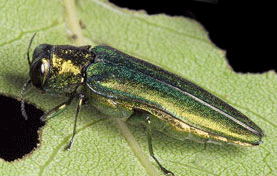The destructive Emerald Ash Borer has been found again, this time in Creston, in southwestern Iowa.
Already, a quarantine on wood is in place in Eastern Iowa, where the pest was first identified in the state.
See more about this latest discovery, and further potential quarantines, from the Iowa Department of Agriculture and Land Stewardship:
CRESTON – Emerald Ash Borer has been positively identified in a residential tree in the city of Creston, the county seat of Union County, making this the fifth location where the invasive beetle has been found in Iowa. EAB kills all ash tree species and is considered to be one of the most destructive tree pests ever seen in North America.
The current EAB infestation was found as a result of an arborist contacting state officials about a suspect ash tree. Investigation by the Iowa EAB Team members revealed characteristic galleries and D-shaped exit holes in dead branches, and a partial adult beetle was positively identified by federal identifiers.
The Iowa EAB Team provides EAB diagnostic assistance to landowners and includes officials from Iowa Department of Agriculture and Land Stewardship (IDALS), Iowa State University Extension and Outreach, the Iowa Department of Natural Resources (DNR), USDA Animal Plant Health Inspection Service and the USDA Forest Service.
EAB infestations had previously been discovered in Allamakee County in May 2010, Des Moines County in July 2013, Jefferson County in August 2013 and Cedar County in October 2013.
“I think we’re seeing the culmination of an EAB population that is finally large enough to detect, coupled with trees readily showing symptoms because of multiple stresses in recent years, including EAB, drought and floods,” said State Entomologist Robin Pruisner of the Iowa Department of Agriculture and Land Stewardship.
A quarantine covering 25 counties in Eastern Iowa was issued on Nov. 1, 2013 intended to slow the accidental movement of EAB by humans. An additional quarantine in response to this new confirmed infestation is being developed. A quarantine restricts movement of hardwood firewood, ash logs, wood chips and ash tree nursery stock out of the quarantined counties.
The Iowa EAB Team strongly cautions Iowans not to transport firewood across county or state lines, since the movement of firewood throughout Iowa or to other states poses the greatest threat to quickly spread EAB even further. Most EAB infestations in the United States have been started by people unknowingly moving infested firewood, nursery plants or sawmill logs. The adult beetle also can fly short distances, approximately 2 to 5 miles.
Ash is one of the most abundant native tree species in North America, and has been heavily planted as a landscape tree in yards and other urban areas. According to the USDA Forest Service, Iowa has an estimated 52 million rural ash trees and approximately 3.1 million more ash trees in urban areas. It is unknown how many public and residential ash trees are located in Creston.
“Forestry Bureau staff with the Iowa Department of Natural Resources have completed 242 urban tree inventories in Iowa, in communities with less than 5,000 residents. Statewide, Iowa averages 16-17% ash on city property, though the ash component can get as high as 87%. There is no inventory for Creston, but we hope this latest infestation will motivate communities that have not taken an inventory of their forestry resources, to do so very soon” said State Forester Paul Tauke.
“Preventive treatments next spring — mid-April to mid-May 2014 — are available to protect healthy and valuable ash trees within 15 miles of the known infested area,” said ISU Extension and Outreach Entomologist Mark Shour. For more details, see ISU Extension and Outreach publication PM2084, www.extension.iastate.edu/Publications/PM2084.pdf<http://www.extension.iastate.edu/Publications/PM2084.pdf>.
To learn more about EAB and other pests that are threatening Iowa’s tree population, please visit www.IowaTreePests.com<http://www.iowatreepests.com/>. Or, for more information contact any of the following members of the Iowa EAB Team:
§ Robin Pruisner, State Entomologist, 515-725-1470, Robin.Pruisner@IowaAgriculture.gov<mailto:Robin.Pruisner@IowaAgriculture.gov>
§ Tivon Feeley, DNR Forest Health Coordinator, 515-281-4915, Tivon.feeley@dnr.iowa.gov<mailto:Tivon.feeley@dnr.iowa.gov>
§ Emma Hanigan, DNR Urban Forest Coordinator, 515-281-5600, emma.hanigan@dnr.iowa.gov<mailto:emma.hanigan@dnr.iowa.gov>
§ Jesse Randall, ISU Extension Forester, 515-294-1168, Randallj@iastate.edu<mailto:Randallj@iastate.edu>
§ Mark Shour, ISU Extension Entomologist, 515-294-5963, mshour@iastate.edu<mailto:mshour@iastate.edu>
§ Laura Jesse, ISU Extension Entomologist, ISU Plant and Insect Diagnostic Clinic, 515-294-0581, ljesse@iastate.edu<mailto:ljesse@iastate.edu>
§ Donald Lewis, ISU Extension Entomologist, 515-294-1101, drlewis@iastate.edu<mailto:drlewis@iastate.edu>.
§ Jeff Iles, ISU Extension Horticulturist, 515-294-3718, iles@iastate.edu<mailto:iles@iastate.edu>


I have been following your coverage on EAB since it started. Are we finding more cases because the pest is spreading, or because there is increased vigilance and awareness? In other words, has the EAB always been around the state, and we’re finding more of them now?
Also Pruisner seems to be saying the infestation is at least partly attributable to recent extreme weather. Like most in IDALS, she doesn’t connect the dots between extreme weather and changes in the hydrological cycle caused by greenhouse gas emissions. Is that an accurate characterization based on your interview with him/her?
Good questions, Paul. Based on what the state experts have been saying, it’s a combination of both vigilance and the pest spreading. It takes 3-5 years for Emerald Ash Borer to kill a tree, so while it hasn’t always been in Iowa, it does take awhile to be detected. It wouldn’t be surprising if places like Cedar Rapids or Iowa City already have an infestation that just hasn’t become visible yet.
I don’t think Ms. Pruisner is trying to make a point about climate change; she’s just saying that trees that are under stress are more susceptible to the ravages of Emerald Ash Borer.